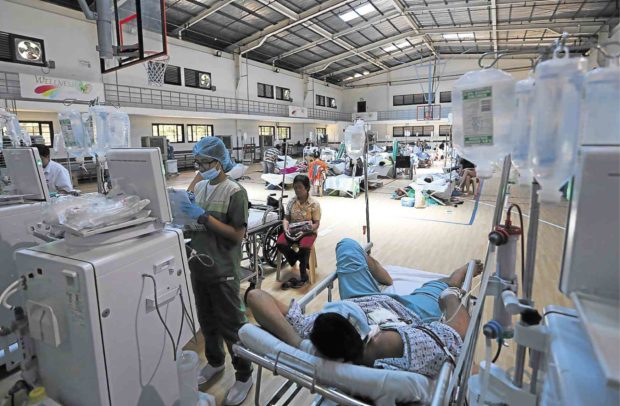
EXTRA WARD The National Kidney Transplant Institute in Quezon City uses its covered basketball court to accommodate a sharp increase in the number of leptospirosis patients. The bacterial disease is usually contracted by people with open wounds and who have waded through contaminated floodwaters. —NIÑO JESUS ORBETA/RICHARD A. REYES
Wading in floodwaters led them to the leptospirosis ward at the National Kidney Transplant Institute (NKTI) in Quezon City, most of the 30 patients in the government hospital agreed.
Mark Ronald Rosario, 17, from Caloocan City, recalled bathing in the rain for half an hour on Wednesday afternoon and feeling faint enough to rush to the hospital some hours later.
Roberto Alfonso Jr., 30, a garbage collector from Cavite City, recounted how he forgot his work boots in the truck and had to wade through the floodwaters that rose quickly after a heavy downpour on Friday.
“At first, I felt back pains. Then my head started throbbing, then my legs and joints became sore. Soon, I could hardly get up,” he said.
When he consulted a doctor three days later, Alfonso was immediately confined.
Serio Babagay, 34, who works as a gardener for San Juan City Hall, said he did not have any open wounds where the Leptospira spirochetes bacteria could have entered.
“But the doctor said the bacteria could have gotten in through my pores,” said Babagay who was also admitted to hospital after three days of being exposed to floodwaters.
Clustering
Over the last few weeks, health officials have seen a clustering of leptospirosis cases because of the severe flooding brought about by heavy rains and the early onset of the wet season.
For the first half of the year, 1,030 cases of leptospirosis have been reported nationwide, with 99 deaths from the water-borne disease, said Health Undersecretary Rolando Enrique Domingo.
The figure was 41 percent higher than what was recorded during the same period last year, when there were 581 leptospirosis cases and 57 deaths. Most of the cases were recorded in Western Visayas (221), the Caraga region (162), and Davao (86), according to the Department of Health (DOH).
DOH monitoring
NKTI director Rosemarie Liquete said the hospital has recorded a total of 84 cases, with 12 deaths, this month.
Over the next two weeks, the DOH will monitor incidents of leptospirosis nationwide to determine if there was a need to declare an outbreak following the continued rise in the number of patients.
Despite the alarming increase in leptospirosis cases, Domingo assured the public that the country’s general hospitals were prepared to take in patients afflicted, and that all regions were well-stocked with antibiotics for it.
The NKTI also has “fast lanes” for leptospirosis patients, with five available dialysis machines for patients who need the treatment.
Health Secretary Francisco Duque III reminded the public that complications from the disease can be prevented if its symptoms were treated immediately.
Symptoms
Among the symptoms of leptospirosis are high fever, muscle pain, bloodshot eyes, chills, severe headaches, vomiting, diarrhea and yellowish skin discoloration.
Others might experience a more severe phase called Weil’s disease with symptoms like liver failure, kidney failure, pulmonary hemorrhage or bleeding from the lungs, cardiac arrhythmias or irregular heartbeat, and septic shock, the result of insufficient blood flow through the body.
Duque said these symptoms appear between seven to 10 days after an individual had been exposed to the Leptospira spirochetes bacteria, which comes from the urine and feces of infected animals like rats, and transmitted when people wade in contaminated floodwaters or ingest contaminated food.
Protective gear
Using protective gear like rubber boots when wading in floodwaters can help prevent exposure to the bacteria, which enters the human body through open wounds or skin lesions, or through the mouth, nose and eyes, the health official said.
Left untreated, leptospirosis can cause kidney failure, brain damage, massive internal bleeding and eventually, death.
In 2017, there were 2,495 cases from January to December. The bulk of the cases last year were from Metro Manila, which accounted for 19.2 percent. —WITH REPORTS FROM JULIA ORNEDO AND ANDREA ALCARAZ; AND RESEARCH FROM CELINE DIOTICIO, CHLARINE GIANAN AND ISABEL CAÑAVERAL